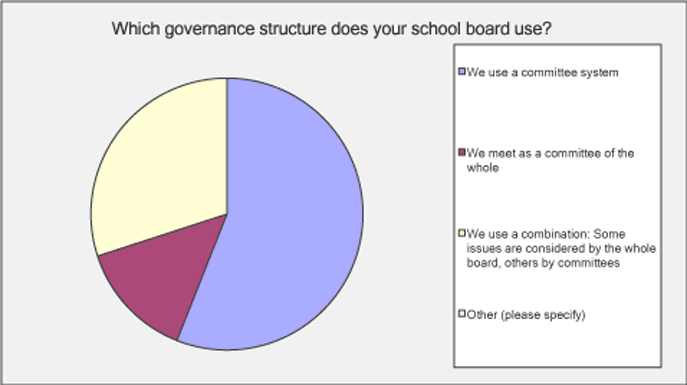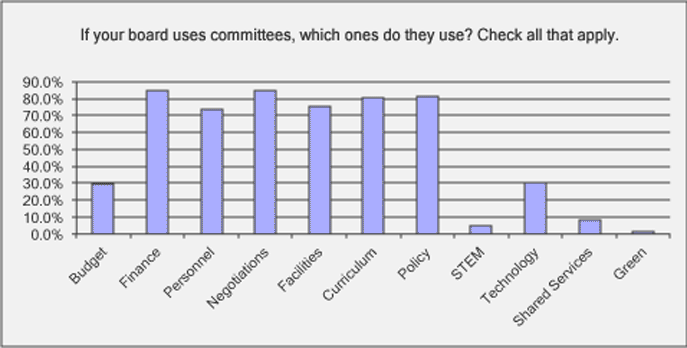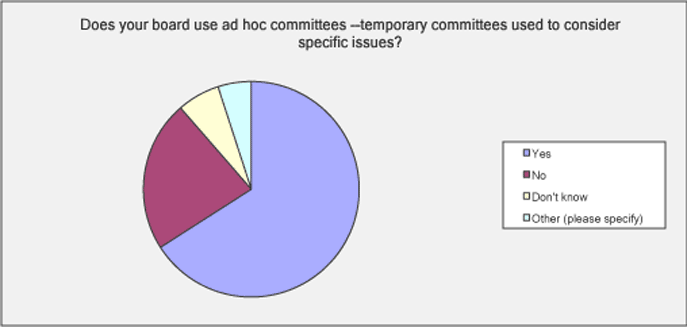The majority of local school boards in the state use a committee system to accomplish their work, according to an informal survey of School Board Notes readers last week.
School boards work in various ways. Some boards use standing committees to do their work (e.g. the finance committee, curriculum committee, etc.) and the committee reports back to the board. In other districts, the board meets as a “committee of the whole,” (the entire board considers all actions). Still others use a combination of the two, or use ad hoc committees as needed. The survey asked readers which system their board uses, as well as asking how well the system works.
Some 56 percent of boards report they use a committee system; 14 percent meet as a committee of the whole, and 30 percent report they use a combination of the two approaches.

Most Frequently Used Committees Of the boards that use committees (or use a combination of the two approaches) there are a few types of committees that an overwhelming majority employ. Those include finance, negotiations, curriculum and policy. In each case, more than 80 percent of respondents have committees that cover those functions. Close behind are personnel and facilities committees.
Other committees mentioned by multiple respondents in comments included community relations, athletics, security, special education, and transportation.

Ad Hoc Committees Nearly 70 percent of respondents noted that their boards have used ad hoc, or temporary, committees for specific purposes. Those committees have included such functions as school security, gifted and talented programs, regionalization, referendums, shared services, negotiations, superintendent search, construction, technology, PARCC assessment, and strategic planning.

Comments The survey elicited extensive comments from School Board Notes readers on how their boards work and how effective they believe their board working style is. The comments are below.
By using the committee of the whole for most items, everyone is aware all the time of items for discussion. Committees are used when it is actually a time saver, such as negotiations, finance at budget time, and curriculum/technology when major initiatives are being “brain-stormed.”
We have used the talents of our members on our committees. For example the accountant is on the budget committee, the teacher is on the curriculum committee; and the member who works with technology is on that committee. This allows each of us to work with what we are comfortable with.
The committee meets, discusses, then presents its findings to the whole board. The board considers the recommendations of the committee.
Committees work well until a committee chair decides the committee is making decisions for rather than recommendations to the board.
Our committee structure works great. Each committee has three board members and three citizen members. This allows for complete transparency within our community.
The committee as a whole approach is more effective as it requires feedback from board members in all areas, not just their “specialty” areas. It also limits the amount of monthly meetings as committees can become cumbersome and time-consuming. I have been at schools that have used both approaches and found that we actually got less done through committees. It also depends on the makeup of your board, their political agendas, if any, and their educational/work backgrounds. (Respondent indicated he/she is a business administrator.)
Nobody wants to be left out from the detailed discussions of most board matters.
Our committee system is very effective. This is because the board members trust one another.
I like committees better. But since some BOE members felt that they were not getting adequate information we decided to go to committee as a whole
We are lucky, as a board – we trust the committees’ work and recommendations.
Our committee structure works very well, with a large board the workload for each person is reduced. When there are openings in a committee (because of someone being unavailable for a meeting) we open it up so that someone can substitute in – this allows more members to be brought up to speed on issues.
Our structure generally works well although at times, it seems that the full board is “out of the loop” on issues under discussion. We are working to improve communication between committees and the rest of the board.
It is a disastrous system laden with mistrust. The system is often abused to the point where we are investigating going to committee of the whole.
Since committee meetings are not subject to OPMA, it allows board members to express opinions they may feel uncomfortable discussing at a public meeting, and it allows board members who are more interested in certain aspects of the district to “hone in” on their interest (curriculum vs. facilities vs. finance).
We have been piloting the hybrid approach to bring more information to the full board.
The committee structure works well because I (as the superintendent) can discuss matters with a small group of board members, they understand the key issues, and then the whole board supports the decisions of the committee.
We rotate the members through all the committees and most members get to chair each committee as well, before moving on to a vice president or president role.
We are dissatisfied with the operation of our committee structure. We are in the process of reexamining the number and scope of the committees with the goal of trimming the number and more clearly defining function.
We only have two committees: Budget & Finance and Negotiations. We love having the board as a whole for everything else so everyone is privy to the same information. There is the opportunity to become more knowledgeable in different areas.
The effectiveness of the board committee structure only works when there is adequate communication and transparency.
Given the size of our school district and the number of issues to discuss, I don’t think working as a committee of the whole would be practical. The committee structure generally works well, and we have recently made some changes to improve it.
Committees allow for more frank discussion between members as opposed to meeting in public as a whole. However the committee structure sometimes leaves other members feeling out of the loop until the regular meeting when the report is given.
The committee structure works for us. Sometimes issues are just too big for the committee to decide and they bring it to the full board at the next public meeting. Also, some issues go from one committee to another before being brought to the full board. It is effective, but it also creates a lot more meetings for the board members (which works for us because all our members put in more time than most other boards).